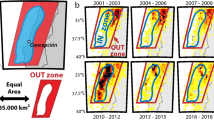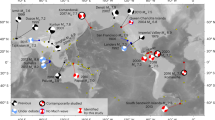Abstract
Maximum earthquake magnitude and the rate of seismic activity apparently differ among subduction zones. This variation is attributed to factors such as subduction zone temperature and stress, and the type of material being subducted1,2,3,4,5. The relative velocity between the downgoing and overriding plates controls their tectonic deformation. It is also thought to correlate with seismicity1,2,6,7,8. Here I use the epidemic type aftershock sequence model9,10 to calculate the background seismicity rate—the frequency of seismic events above magnitude 4.5—for 117 sections of subduction zones worldwide, during the past century. I demonstrate a proportionality relationship whereby relative plate velocity correlates positively with seismicity rate. This relationship is prominent in the southwestern Pacific Ocean. However, although seismically active, this region has not experienced a magnitude 9 earthquake since 1900. In contrast, the Cascadia, Nankai, southern Chilean and Alaskan subduction zones exhibit low background seismicity rates, yet have experienced magnitude 9 earthquakes in the past century. Slow slip occurs in many of these regions, implying that slow deformation may aid nucleation of very large earthquakes. The proportionality relationship could be used to assess the seismic risk between two endmembers: active subduction zones that generate moderate earthquakes and quiet subduction zones that generate extremely large earthquakes.
This is a preview of subscription content, access via your institution
Access options
Subscribe to this journal
Receive 12 print issues and online access
$259.00 per year
only $21.58 per issue
Buy this article
- Purchase on Springer Link
- Instant access to full article PDF
Prices may be subject to local taxes which are calculated during checkout




Similar content being viewed by others
References
Uyeda, S. & Kanamori, H. Back-arc opening and the mode of subduction. J. Geophys. Res. 84, 1049–1061 (1979).
Ruff, L. & Kanamori, H. Seismicity and the subduction process. Phys. Earth Planet. Inter. 23, 240–252 (1980).
Clift, P. & Vannucchi, P. Controls on tectonic accretion versus erosion in subduction zones: Implications for the origin and recycling of the continental crust. Rev. Geophys. 42, RG2001 (2004).
Heuret, A., Conrad, C. P., Funiciello, F., Lallemand, S. & Sandri, L. Relation between subduction megathrust earthquakes, trench sediment thickness and upper plate strain. Geophys. Res. Lett. 39, L05304 (2012).
Scholz, C. H. & Campos, J. The seismic coupling of subduction zones revisited. J. Geophys. Res. 117, B05310 (2012).
Kreemer, C., Holt, W. E. & Haines, A. J. in Plate Boundary Zones (eds Stein, S. & Freymueller, J. T.) (American Geophysical Union, 2002).
Bird, P., Kagan, Y. Y., Jackson, D. D., Schoenberg, F. P. & Werner, M. J. Linear and nonlinear relations between relative plate velocity and seismicity. Bull. Seismol. Soc. Am. 99, 3097–3113 (2009).
Singh, S. K., Comte, D. & Pardo, M. Background seismicity and strength of coupling in the subduction zones. Bull. Seismol. Soc. Am. 82, 2114–2125 (1992).
Ogata, Y. Statistical models for earthquake occurrences and residual analysis for point processes. J. Am. Stat. Assoc. 83, 9–27 (1988).
Ogata, Y. Seismicity analysis through point-process modeling: A review. Pure Appl. Geophys. 155, 471–507 (1999).
Stein, S. & Okal, E. A. Ultralong period seismic study of the December 2004 Indian Ocean earthquake and implications for regional tectonics and the subduction process. Bull. Seismol. Soc. Am. 97, S279–S295 (2012).
McCaffrey, R. Global frequency of magnitude 9 earthquakes. Geology 36, 263–266 (2008).
Kagan, Y. & Jackson, D. D. Tohoku earthquake: A surprise? Bull. Seismol. Soc. Am. 103, 1181–1194 (2013).
Holtkamp, S. G. & Brudzinski, M. R. Earthquake swarms in circum-Pacific subduction zones. Earth Planet. Sci. Lett. 305, 215–225 (2011).
Chu, A., Schoenberg, F. P., Bird, P., Jackson, D. D. & Kagan, Y. Y. Comparison of ETAS parameter estimates across different global tectonic zones. Bull. Seismol. Soc. Am. 101, 2323–2339 (2011).
McGuire, J. J., Boettcher, M. S. & Jordan, T. H. Foreshock sequences and short-term earthquake predictability on East Pacific Rise transform faults. Nature 434, 457–461 (2005).
Llenos, A. L., McGuire, J. J. & Ogata, Y. Modeling seismic swarms triggered by aseismic transients. Earth Planet. Sci. Lett. 281, 59–69 (2009).
Kumazawa, T., Ogata, Y. & Toda, S. Precursory seismic anomalies and transient crustal deformation prior to the 2008 Mw = 6.9 Iwate-Miyagi Nairiku, Japan, earthquake. J. Geophys. Res. 115, B10312 (2010).
Okutani, T. & Ide, S. Statistic analysis of swarm activities around the Boso Peninsula, Japan: Slow slip events beneath Tokyo Bay? Earth Planets Space 63, 419–426 (2011).
Bird, P. An updated digital model of plate boundaries. Geochem. Geophys. Geosyst. 4, 1027 (2003).
Mooney, W. D., Laske, G. & Masters, T. G. CRUST 5.1: A global crustal model at 5°×5°. J. Geophys. Res. 103, 727–747 (1998).
Kanamori, H. & Anderson, D. L. Theoretical basis of some empirical relations in seismology. J. Geophys. Res. 65, 1073–1095 (1998).
Kerr, R. A. More megaquakes on the way? That depends on your statistics. Science 332, 411 (2011).
Daub, E. G., Ben-Naim, E., Guyer, R. A. & Johnson, P. A. Are megaquakes clustered? Geophys. Res. Lett. 39, L06308 (2012).
Satake, K., Shimazaki, K., Tsuji, Y. K. & Ueda, K. Time and size of a giant earthquake in Cascadia inferred from Japanese tsunami records of January 1700. Nature 379, 246–249 (1996).
Schwartz, S. Y. & Rokosky, J. M. Slow slip events and seismic tremor at circum-Pacific subduction zones. Rev. Geophys. 45, RG3004 (2007).
Beroza, G. C. S. & Ide, S. Slow earthquakes and non-volcanic tremor. Annu. Rev. Earth Planet. Sci. 39, 271–296 (2011).
Ide, S. Variety and spatial heterogeneity of tectonic tremor worldwide. J. Geophys. Res. 117, B03302 (2012).
Heki, K. & Kataoka, T. On the biannually repeating slow-slip events at the Ryukyu Trench, southwestern Japan. J. Geophys. Res. 113, B11402 (2008).
Lanza, J. C. V. et al. A slow slip event and synchronous seismicity in the northern Peru subduction zone. EOS Trans. AGU (Fall Meet. Suppl.) 93, S41S03 (2012).
Acknowledgements
This work was supported by JSPS KAKENHI (23244090) and MEXT KAKENHI (21107007). Figures were prepared using Generic Mapping Tool (Wessel and Smith, 1998).
Author information
Authors and Affiliations
Corresponding author
Ethics declarations
Competing interests
The author declares no competing financial interests.
Supplementary information
Supplementary Information
Supplementary Information (PDF 452 kb)
Rights and permissions
About this article
Cite this article
Ide, S. The proportionality between relative plate velocity and seismicity in subduction zones. Nature Geosci 6, 780–784 (2013). https://doi.org/10.1038/ngeo1901
Received:
Accepted:
Published:
Issue Date:
DOI: https://doi.org/10.1038/ngeo1901
This article is cited by
-
A review on slow earthquakes in the Japan Trench
Progress in Earth and Planetary Science (2023)
-
The hot zones of global Mw ≥ 5 earthquakes and their decadal migration during 1989–2019
Arabian Journal of Geosciences (2022)
-
Depth variation of seismic moment and recurrence interval in Japan
Geoscience Letters (2021)
-
Spatial variations in seismicity characteristics in and around the source region of the 2019 Yamagata-Oki Earthquake, Japan
Earth, Planets and Space (2021)
-
Contemporary deformation and seismicity analysis in Southwest Japan during 2010–2018 based on GNSS measurements
International Journal of Earth Sciences (2019)



